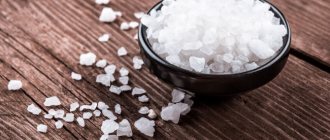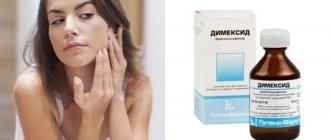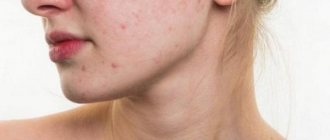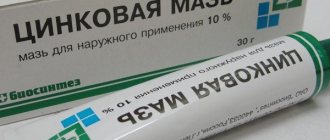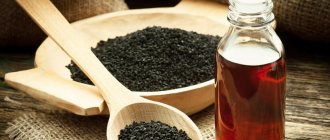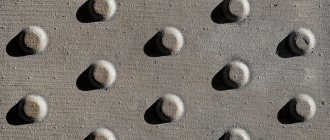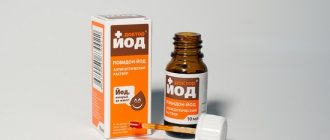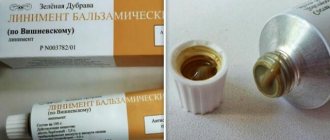Why peroxide?
Hydrogen peroxide is usually used for skin lesions, as it allows the wound to be cleaned of dirt, blood, and purulent elements. In general, it helps to disinfect the wound. It cannot be said that hydrogen peroxide has sterilizing properties, but it helps reduce the number of microorganisms many times over.
The substance itself is quite unstable. When it gets on the wound, it is no longer hydrogen peroxide, but water and active oxygen. Externally, this manifests itself in strong foaming. Due to this, mechanical impurities are removed from the wound and from the surface of the skin.
Anti-acne scrub recipes
Masks will not provide the necessary results in the fight against blackheads. The best assistant in this matter is a scrub.
Recipe for a scrub with peroxide based on sea salt: the substances are mixed in equal proportions, but the main condition is the absence of aromatic additives in the sea salt. Gently rub the mixture onto the face, excluding the lips and eyelids. Wash off first with warm and then with cold water.
The scrub can also be prepared using soda. In ½ tsp. soda dissolve 3-4 drops of peroxide. Rub the resulting mixture onto the skin using massaging movements. Rinse with water.
Is it possible to wipe your face?
You should absolutely not use hydrogen peroxide to wipe your facial skin against acne. Even if it is a one or three percent solution. Hydrogen peroxide can burn the skin, not just the pimple.
That’s why, before applying the product to your face, trying to remove a pimple in this way, conduct a small experiment. Of course, if you wish. Take a cotton pad and soak it in hydrogen peroxide. Hold it in your hands for a couple of minutes. White spots will appear on the skin, and they will not go away quickly. If you wipe your face, you can see the same thing. In the worst case, necrosis will develop.
In order to avoid sad consequences, hydrogen peroxide in its pure form for acne can only be used when you have opened it. Of course, you shouldn’t squeeze out a pimple, but if you have already done this, then the resulting wound must be cleaned. Also, a boil can “ripen” and burst spontaneously.
Treating with hydrogen peroxide is not only possible, but also necessary, as the product will help stop bleeding. Prevent the penetration of microorganisms inside, wash off the remaining pus.
Indications for use
In the field of cosmetology, peroxide is used to combat the following conditions:
- acne;
- cleansing the skin of blackheads;
- treatment of purulent skin inflammations;
- dark spots;
- freckles;
- greasy shine;
- the need for skin whitening after therapy.
Achieving the maximum effect is possible if you use peroxide in the fight against temporary acne (appears periodically in small groups), with rashes due to colds, if the cause of acne is skin infection.
For the treatment of general systemic diseases, the drug is taken orally (diluted) and externally in the form of rinsing, applications, lubrication, and application with tampons. General indications include:
- skin diseases (eczema, psoriasis, warts, candidiasis);
- diseases of the gums and teeth (stomatitis, gingivitis, periodontal disease);
- diseases of the ENT organs (rhinitis, pharyngitis, otitis media, sinusitis);
- neurological disorders (osteochondrosis, multiple sclerosis);
- diseases of the respiratory system (bronchitis, bronchiectasis);
- acute respiratory viral infections.
How to use peroxide?
Take a cotton swab and soak it generously in the solution.
Press the pimple directly with this stick several times. It needs to be done more than once, because it is important to stop bleeding and pus.
If necessary, change the wand.
Thus, hydrogen peroxide is used for acne once. You should not act on inflammation and the surrounding tissues (and 6tu4ka.ru is sure that you definitely cannot do without affecting healthy tissues, no matter how hard you try to act only on the rash) for too long, so as not to damage healthy cells.
Safety precautions and side effects
Hydrogen peroxide is a very strong product that, if used incorrectly, can cause harm to the skin, so it must be used with extreme caution, following all the rules .
- An undiluted peroxide solution should not be used on large areas of skin. Treatment of acne with a concentrated composition should be done pointwise, and not by wiping the entire surface.
- Do not use peroxide every day - this can cause not only burns, but even tissue necrosis.
- Carry out complex treatment, taking medications orally that help get rid of acne (of course, only after prior consultation with a specialist).
If there is a rash on the skin
If not just one pimple appears, but several, you can wipe your face, but you need to do it correctly. To do this, pharmaceutical peroxide is diluted with clean water tenfold.
But this does not mean that you can wipe your face this way many times. No more than 2 days, 1-2 times a day. It is believed that each pimple will significantly decrease and dry out. However, the method does not always help. The rash may remain. Then it’s worth looking for what their cause is, to see what processes in the body affect this reaction of your skin.
Remove acne with peroxide
This drug is good not only because it significantly lightens the skin, but also heals it. Acne is nothing more than an accumulation of pathogenic microbes in the pores; peroxide has disinfectant properties. To quickly solve this problem, simply lubricate the damaged area with a 3% hydrogen solution.
A foam forms on the skin, which is a consequence of a chemical reaction. It is this compound that “removes” all the dirt and infection from the pores of the face. Afterwards, it is recommended to lubricate the skin with some soothing agent, say, a decoction of chamomile or thyme.
Many people are wondering whether hydrogen peroxide or salicylic acid is better for acne, and the answer depends on the purpose and skin type. From my own experience I can say that salicylic acid does not dry out acne. On my oily dermis, she literally created the ideal atmosphere for the accumulation of new microbes, while the peroxide and talc, which she used for acne spots, quickly dried out all the ulcers and wet wounds.
We suggest you familiarize yourself with Stye on the bridge of the nose near the eye
The principle of operation of peroxide is such that it literally burns all microorganisms in its path. This product cannot be used for total application to the face, only spot-on. Moreover, girls with dry skin need to be very careful; there are cases when, due to peroxide, wounds became inflamed again. Thus, it helps not only to disguise acne, but also to cure it.
This mask recipe works well:
- peroxide;
- aloe;
- natural flower honey;
- iodine.
For a spoonful of aloe juice, take a spoonful of honey and a drop of iodine and peroxide. Mix everything, apply the mixture to the entire face in a relatively thin layer. Wash off after 20 minutes.
Remember, this mixture will lighten the skin, so if a person has dark or dark skin, it is better not to experiment.
Hydrogen peroxide also helps against acne when mixed with minerals; this recipe is suitable for oily and combination skin. We will need badyaga, blue clay, peroxide. Mix the powders together, add a spoonful of chamomile decoction if necessary. Apply only to affected areas, leave until hardened.
A peroxide and egg mask will help against acne; there are very good reviews about it. Beat one chicken egg until white foam, add a spoonful of hydrogen and mix. Wipe your face with the resulting mixture using a cotton swab, rinse after 10 minutes.
Photo - Preparations for peroxide masks
A very interesting question: does peroxide help with acne and acne on the back? It all depends on the condition of the acne; if the wounds are open and inflamed, then it is better to first apply formic alcohol (also spot-on), and only at the end of treatment, smear the body with a peroxide solution to remove the spots.
In addition, each time after using peroxide, it is necessary to smear the skin with a nourishing cream to avoid inflammation and dry areas.
To get rid of teenage problems: rashes and acne, diluted hydrogen peroxide against acne will help. Take 4 tablespoons of the product per glass of water, stir well and wash with the liquid. This treatment will help solve the problem of age spots and redness, especially with regular use - 2 times a day.
As part of other products
And yet, rarely does anyone use hydrogen peroxide for acne in its pure form. In order to smooth out side effects such as spots and burns on the skin, add hydrogen peroxide to your usual toner. If the bottle contains 50 ml, then there are no more than 5 drops of solution. The face needs to be wiped a couple of times every 7 days.
Sometimes the antiseptic effect is enhanced by yeast. They soften the irritating effect of peroxide on the healthy skin surrounding the pimple itself.
Take a couple of tablespoons of dry yeast (it doesn’t matter what kind, everything usually helps: from beer yeast to baker’s yeast). Dilute in a solution of hydrogen peroxide. Apply pointwise to each pimple, making 3 layers. Apply alternately. Wait for the previous layer to dry, only then apply the next one. When the final “touch” is applied, wait another five minutes and wash off with warm, plain running water.
Mask recipes
Before use, you should find out whether they can be used for your skin. Such formulations should not be used by people who may have:
- dry, flaky skin;
- individual sensitivity to the drug;
- various diseases (except acne and acne);
- wounds and skin injuries.
The video explains whether it is possible to wipe (cauterize) acne with hydrogen peroxide, and whether this procedure helps at all:
https://youtube.com/watch?v=UCvyRPthEyQ
By the way, hydrogen peroxide will be needed for people who:
- oily skin;
- there are freckles and pronounced pigmentation;
- pores are enlarged.
Treatment with honey composition
To prepare a honey mask for acne, you will need to take one tbsp. a spoonful of honey and aloe juice, and add two drops of iodine and hydrogen peroxide to them. All ingredients are thoroughly mixed and then applied to problem areas. Leave for a quarter of an hour and wash off. This must be done, preferably with warm water.
Yeast for acne
To prepare a yeast face mask, you need to mash twenty grams of regular yeast with a fork in a ceramic bowl. Then add 1 tablespoon of peroxide solution to them. Mix everything until it reaches the consistency of sour cream. If using dry yeast, take the contents of half a sachet and add a small amount of water. After they dissolve, you need to add peroxide. This is the only mask that can be left on the face for twenty minutes. Then it is thoroughly washed off with warm water. During its action, you need to relax your facial muscles; this is best done while lying down. After using such a mask, you should wipe your face with chamomile decoction, which will soothe the skin and prevent dryness and irritation.
Purifying face mask
To prepare this acne cleansing mask, you will need shaving cream (you can use both women's and men's). One of his articles the spoon should be diluted in 50 ml of water (mineral or simply filtered), then add 5 ml of camphor or ammonia and 4 ml of hydrogen peroxide to the resulting mixture. Mix all ingredients carefully. Apply the composition directly to the face and wash off after a quarter of an hour. After using it, the pores will noticeably narrow and the skin will get rid of impurities.
From blackheads
Take two tablespoons of white clay, which can be purchased at the pharmacy. Then one tbsp is added to it. spoons of hydrogen peroxide and lemon juice. Everything is rubbed together and applied to the skin. And after ten minutes it is washed off with cool water. After this mixture, be sure to lubricate your face with cream. This product lightens the spots and removes dirt from them. It is especially effective if applied to steamed skin. An acne mask with lemon can be made with honey, without adding peroxide.
Using a curd mask
For it you need to take Art. spoon of homemade cottage cheese or heavy cream and combine with 8 drops of hydrogen peroxide. They should be mixed together, and if cream is used, the latter should be whipped and applied to the skin of the face. Leave this mask on for a quarter of an hour and then wash it off.
Anti-stain mask with badyaga
This component enhances the effect of hydrogen peroxide against acne and blemishes. It is able to eliminate long-standing spots and the consequences of post-acne. It is often used as a scrub. It is available for sale in powder and gel form. Badyaga can improve skin breathing and increase the supply of oxygen to all its cells. It serves as a conductor of peroxide for its deep penetration into the subcutaneous capillaries and participates in cleansing contaminated pores. This feature helps reduce the activity of the sebaceous glands.
To prepare the product, you need to take 5 grams of badyagi and 7 drops of peroxide. Mix all this and apply to your face. Leave for 10 minutes and rinse. This mask helps get rid of old and new scars, eliminate wrinkles and pimples.
This mask is contraindicated if you have:
- allergy to its components;
- thin and dry facial skin;
- rosacea;
- peeling is observed;
- hypertrichosis.
Face masks with peroxide are a real godsend for problematic and oily skin. They are able to cope with any acne that is not caused by internal diseases. Not only is the skin superficially cleansed, but deeper impurities are also removed. Using formulations with peroxide, you can get rid of annoying freckles and eliminate strong pigmentation on the face. Their correct use will lead to recovery of the skin from acne at any age.
Against severely inflamed acne
In this case, it is recommended to try local masks with streptocide. Take a teaspoon of crushed streptocide tablets, the same amount of baby powder, mix with hydrogen peroxide until the consistency resembles a liquid slurry. We repeat once again: apply strictly to inflamed areas
. Then remove it with a cotton pad. The mask should not be used more than once a week.
Anyone who has used peroxide in one way or another knows that the substance has a lightening effect. Therefore, some even try to use it to remove stains remaining on the skin after rashes. If you do this, you need to be very careful, because there is a high risk of burning the skin.
Does hydrogen peroxide help with acne, comedones and acne marks?
Hydrogen peroxide (H202) is a colorless liquid with a slight specific odor.
It consists of water (H2O) and atomic oxygen (O).
The drug is sold in pharmacies without a prescription.
Its price is from 5.9 rubles. per 100 ml of 3% solution.
Main properties of hydrogen peroxide:
- antiseptic – stops the proliferation of microbes;
- disinfectant – destroys pathogens;
- hemostatic – promotes the formation of blood clots in small vessels;
- deodorizing – eliminates unpleasant odors by destroying putrefactive microflora.
In high concentrations (more than 30%), the substance causes depigmentation (lightening) of the skin, hair and mucous membranes, and also has an irritating effect.
Is hydrogen peroxide effective for acne? Their appearance is associated with the activity of bacteria accumulated in the pores of the skin. Due to its disinfectant properties, the solution has an anti-inflammatory effect and helps reduce defects, just like cream with azelaic acid. To combat comedones and acne marks, peroxide must be used together with other components.
For acne caused by hormonal imbalance or diseases of internal organs, hydrogen peroxide is not able to have a pronounced effect. The drug helps only with isolated inflammatory elements, the appearance of which is associated with clogging of pores with sebum and dirt particles.
Mechanism of action for acne
Hydrogen peroxide is an unstable substance. Upon contact with the skin, under the influence of the enzymes catalase and peroxidase, it is converted into water and oxygen in active form.
The mechanism of action of hydrogen peroxide for acne:
- free oxygen oxidizes the organic components of anaerobic putrefactive bacteria, stopping the process of their reproduction;
- foam, which is actively formed from water and oxygen, captures and removes from the skin particles of dirt, pus, fat, fragments of microbes, dead scales of the epidermis, and so on;
- if the pimple is damaged, the solution washes out blood clots and helps stop its secretion;
- By destroying pathogenic microflora, the drug activates local skin immunity.
The effect of using hydrogen peroxide is especially noticeable for pustules - purulent elements on the skin. After lubricating the opened bubbles with the solution, the healing process accelerates. If the pimple looks like a papule - a dense, inflamed red nodule, then the drug may be of little use.
If used incorrectly, the oxidizing properties of hydrogen peroxide can cause damage to healthy skin. A concentrated solution can cause a burn, and too frequent use of the drug can cause dryness of the epidermis.
Stopproblem salicylic lotion has proven itself to be excellent in the fight against acne.
Read about the beneficial properties of whey for skin here.A simple video recipe for lifting a mask around the eyes https://ilcosmetic.ru/uhod-za-litsom/lifting/maski-s-effektom-liftinga.html
How does peroxide work on acne?
The main factors for the appearance of acne are an excessive increase in sebum production, the rapid rate of desquamation of epidermal scales and the proliferation of acne bacteria. As a result of their vital activity, bacteria produce enzymes that cause the appearance of inflammatory elements. Peroxide, when applied to the skin and when interacting with oxygen, quickly decomposes into singlet oxygen and water. It is active oxygen that has a toxic effect on bacteria and their number is sharply reduced.
Hydrogen peroxide against acne works in several ways:
- removes pus by forming a hissing foam on the surface of the pimple;
- kills microorganisms, including acne bacteria, which are provocateurs of pustular neoplasms on the skin;
- Lightens pigmentation and stagnant acne spots.
It is ineffective and unsafe to use peroxide for acne on the face, which is located under the skin and for closed comedones. The solution works best with purulent acne when the necrotic contents come out. In this case, peroxide cleanses the ulcer well from the remaining purulent mass.
Important! Peroxide against acne only helps if the causes of their appearance are related to external factors. Acne caused by hormonal disorders, internal diseases, or those of a genetic nature can be treated with peroxide to no avail, since it does not affect the cause of its appearance.
